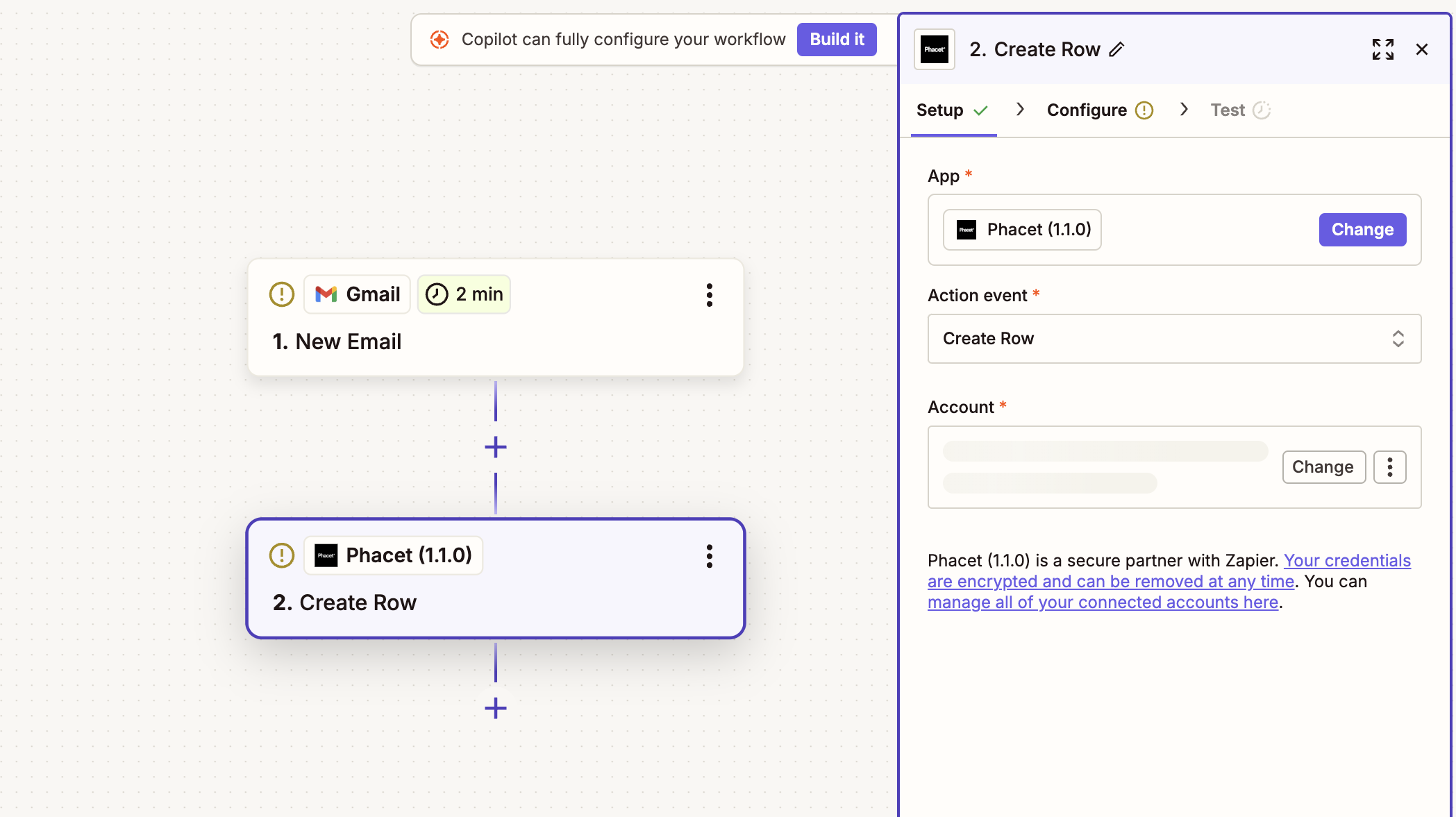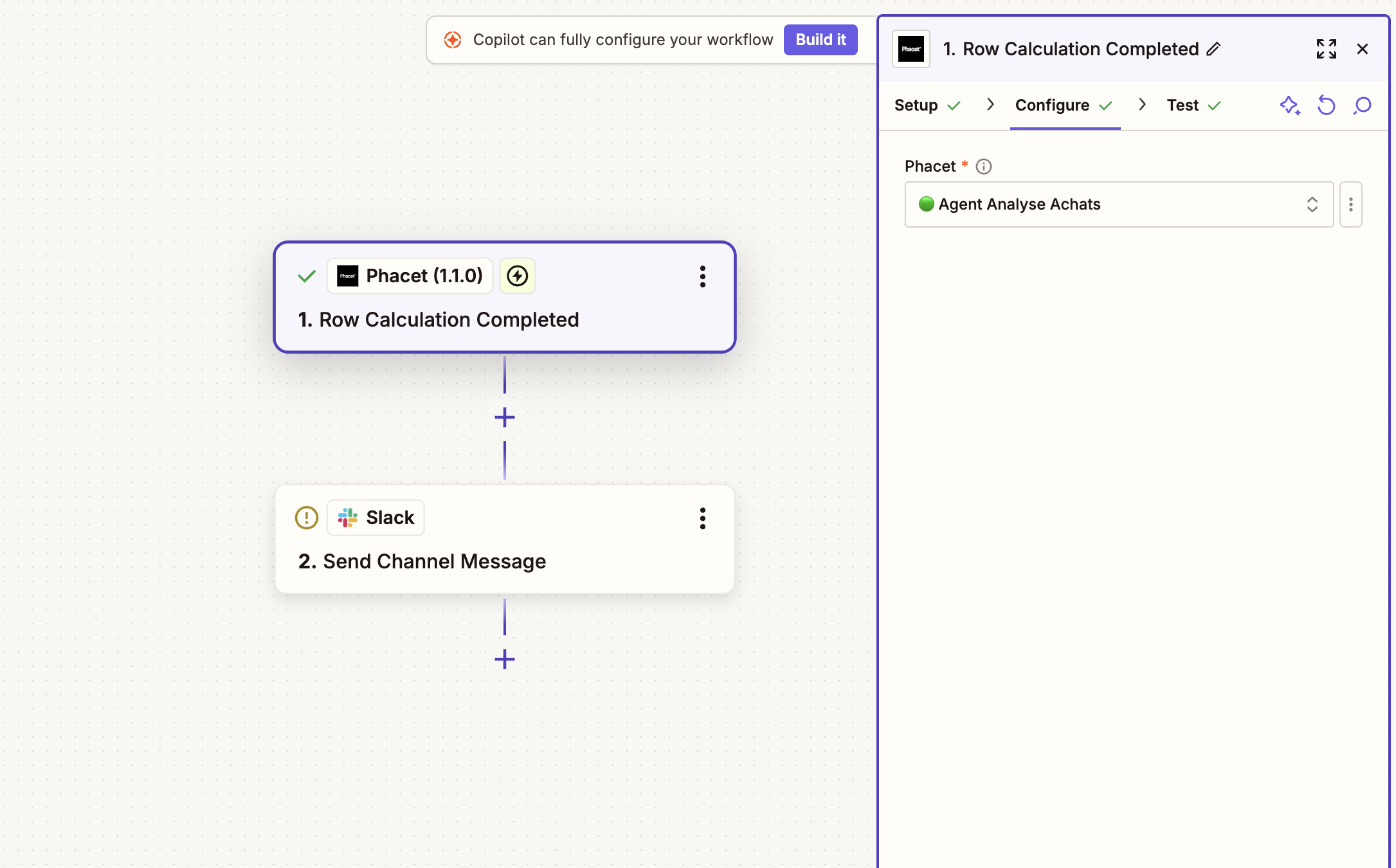Zapier : connect Phacet workflows to your apps
The Phacet Zapier app lets you connect Phacet to hundreds of external tools—no code required. Use it to embed Phacet into existing processes and automate multi-step workflows.
Zapier chains Triggers and Actions into workflows called Zaps: when something happens in one tool (a trigger), Zapier performs a defined action in another—like sending new data to Phacet or reacting to updates in your workspace.
Why use it?
- Eliminate manual exports and cross-tool copy/paste
- Trigger Phacet based on live events from other apps (e.g., “file uploaded,” “form submitted”)
- Push Phacet results to downstream systems automatically (e.g., “send a Slack alert when a mistake is found in an invoice”)
- Create tight feedback loops across AI, automation, and human review
How it works
The app uses your Phacet API key with Zapier’s Triggers and Actions model:
- Trigger → Phacet: External apps send data to Phacet.
- Phacet → Action: Phacet outputs trigger actions in your stack.
You keep full control over access via API keys.
How to set up Phacet and Zapier integration
Note : Only Admin users can set up the Phacet Zapier connection as it requires the ability to manage API keys in Phacet.
The Phacet Zapier App is currently in Private Access.
To access it use the following invite link
Use Case 1: External Trigger → Action in Phacet
Automate Phacet actions when something happens in your external tool (e.g., Airtable, Salesforce, Google Drive).
1. Authentication
- Access the Phacet App in Zapier (using the private link shared previously).
- Generate an API Key in Phacet from your Settings > API keys dashboard
- Open the Phacet App in Zapier
- Connect Phacet to Zapier with the provided API key.
2. Trigger Setup (External Tool)
- Choose the app and event that will trigger the workflow (e.g., “New Spreadsheet Row” in Google Sheets).
- Follow Zapier’s setup to test and capture a sample row.
3. Action Setup (Phacet)
- Choose the Phacet action (e.g., “Create Row”, “Run AI Tool”).
- Select the target Phacet and Session.
- Map fields from your trigger app to columns in your Phacet.
- Test the automation on the sample row
4. Activate
- Name your Zap and turn it on. It will now run automatically based on the trigger.

In this example, new emails are sent to a Phacet for labelling and sorting.
Use Case 2: Trigger from Phacet → Action in Another App
This method will let you use Phacet’s native triggers directly within Zapier—no webhook setup required.
- Select Phacet as the trigger app in Zapier.
- Select the trigger event
- Select the Phacet (you cannot select a specific session)
- Test the trigger to validate that events are properly captured
- Choose the action in your target tool (e.g., send Slack message)
- Map the values from the Phacet app to your target tool.
- Test and publish.

In this example, a message is sent to Slack every time Phacet complete ana analysis on a row.
Available Triggers & Actions
| Type | Event Name | Description |
|---|---|---|
| Trigger | Phacet Created | Triggers when a new Phacet is created. |
| Trigger | Row Calculation Completed | Triggers when a row calculation completes successfully in a Phacet. |
| Trigger | Row Calculation Failed | Triggers when a row calculation fails in a Phacet. |
| Trigger | Row Calculation Started | Triggers when calculations is initiated on a row in Phacet |
| Trigger | Row Created | Triggers when a new row is created in a Phacet. |
| Action | Create Row | Creates a row in a specific Phacet and Session. |
| Action | Get Row | Retrieves a row by its ID from a specific Phacet. Use this after receiving a webhook to get the complete row data. |
| Action | Update Row | Updates an existing row in a specific Phacet with new cell values. |
📌 Business implementation Examples
Below are common automation patterns our finance and admin users build with Phacet and Zapier—each turning manual, repetitive tasks into seamless workflows.
| Use Case | Example |
|---|---|
| 📬 Email inbox sorting and routing | Gmail emails received in a shared inbox are automatically routed to a Phacet. The content is analyzed by AI to classify the request and assign it to the right person, with a topic label (e.g. invoice, legal, admin). |
| 📥 Email intake → Document extraction | Incoming vendor invoices received via Gmail are routed to a Phacet. Key data (supplier name, amount, VAT, due date) is extracted and structured for reconciliation. |
| 📄 Drive folders → Contract parsing | A contract uploaded to Google Drive triggers a Zap that sends it to Phacet. AI parses terms (e.g., renewal date, notice period) and updates a master legal tracker. |
| 🧾 Invoice matching & validation | A new invoice created in an ERP automatically flows into Phacet. It is matched against purchase orders to flag price discrepancies or missing data. |
| 📬 CRM form submission → Request classification | A web form submission from HubSpot (e.g., vendor onboarding or budget request) triggers a Zap that sends the form to Phacet. Phacet classifies it by topic and urgency. |
| 💳 Expense approval workflows | Expense reports submitted via a Typeform or Excel are routed to Phacet. AI extracts and checks values against policy thresholds, triggering alerts if needed. |
| 📊 Monthly report automation | At month-end, financial reports generated by an ERP (e.g., Sage, Netsuite) are pushed into Phacet for AI-based KPI extraction and summary generation, then sent to Slack or Notion. |
Troubleshooting
If your Zap doesn’t behave as expected:
- Visit Zapier’s Connections Page to disconnect and reconnect apps.
- Review Zapier Troubleshooting page for common fixes.
- For issues tied to Phacet-specific behavior, contact our Support Team.
Updated 2 months ago